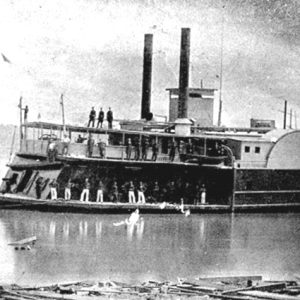calsfoundation@cals.org
USS Queen City
Rear Admiral David Dixon Porter authorized the U.S. Navy’s purchase of the wooden-hulled, side-wheel commercial ferryboat the Queen City from Samuel Wiggins of Cairo, Illinois, for $16,000 at Cincinnati, Ohio, on February 13, 1863. The navy retained the vessel’s original name, which honored the city of Cincinnati, and commissioned it as the USS Queen City on April 1, 1863.
Converted for use as part of the so-called tinclad fleet and assigned identification number 26, the USS Queen City was one of the few tinclads actually to carry iron plating. Fitted with 1.25 inch iron plating, the USS Queen City weighed 212 tons and carried a crew of sixty-five sailors and officers. The ship’s identification number is visible on the pilothouse in at least one wartime photograph. This fourth-class steamer initially carried a battery of two thirty-pound Parrott rifles, two thirty-two-pounders, and four twenty-four-pound Howitzers.
As with all of the Union navy’s tinclad ships, whose lighter protection allowed for greater speed and mobility than the heavier ironclads, the USS Queen City operated in the relatively shallow waters of strategically significant Mississippi River tributaries. The USS Queen City began active service under the command of Acting Master Jason Goudy and served throughout the spring of 1863 on the Tennessee River in support of Union army operations. Transferred to the Mississippi River Squadron by the summer of 1863, the USS Queen City conducted regular patrols to protect Union army supply and communication lines with forces stationed near Vicksburg, Mississippi. On October 7, 1863, the USS Queen City reported the addition of one twelve-pound Howitzer to its battery.
By the fall of 1863, the USS Queen City served largely as a troop transport. On October 13, 1863, the USS Queen City transported troops from Helena (Phillips County) in support of operations against the town of Friars Point, Mississippi. This operation resulted in the capture of a large supply of Confederate cotton on October 14. Thereafter, the USS Queen City conducted regular patrols on various rivers throughout Arkansas.
While patrolling the White River near Clarendon (Monroe County) on June 24, 1864, two regiments of Confederate cavalry and four artillery pieces of Brigadier General Joseph O. Shelby’s brigade ambushed, disabled, and temporarily captured the USS Queen City. During this engagement, the ship’s crew reportedly suffered casualties of at least six killed, nine wounded, and twenty-six captured. Nearby Union vessels rescued the ship’s remaining crew members. Shelby’s troops removed two of the ship’s twenty-four-pound Howitzers, small arms and ammunition, and other miscellaneous supplies. Shelby’s force blew up the USS Queen City when the USS Tyler, the USS Fawn, and the USS Naumkeag approached in support. Federal troops recaptured at least one of the howitzers during a skirmish at Pikeville (Monroe County) on June 26, 1864. The USS Tyler later recovered the remaining two twenty-four-pound Howitzers and one thirty-two-pounder, while the USS Exchange recovered an unspecified gun.
Salvage diving conducted after the war recovered the ship’s machinery, while modern marine archaeological surveys performed by the University of Missouri–Columbia and the National Park Service discovered its remaining sunken structure.
For additional information:
Christ, Mark K. “The Queen City Was a Helpless Wreck: J. O. Shelby’s Summer of ’64.” In “The Earth Reeled and the Trees Trembled,” Civil War Arkansas, 1863–1864. Little Rock: Old State House Museum, 2007.
Edwards, John M. Shelby and His Men, or, the War in the West. Kansas City, MO: Hudson-Kimberly, 1897.
Garrison, Ervan G., J. Alan May, and William H. Marquardt. “Search for the U.S.S. Queen City: Instrument Survey, 1977.” In Beneath the Waters of Time: The Proceedings of the Ninth Conference on Underwater Archaeology, edited by J. Barto Arnold III. Austin: Texas Antiquities Committee, 1978.
Konstam, Augus. Mississippi River Gunboats of the American Civil War, 1861–1865. New York: Osprey Publishing Company, 2002.
McPherson, James M. War on the Waters: The Union and Confederate Navies, 1861–1865. Chapel Hill: University of North Carolina Press, 2012.
Smith, Myron J. Tinclads in the Civil War: Union Light-Draught Gunboat Operations on Western Waters, 1862–1865. Jefferson, NC: McFarland, 2009.
United States Naval War Records Office. Official Records of the Union and Confederate Navies in the War of the Rebellion. Series 1, Volume 26. Naval Forces on Western Waters (March 1, 1864–December 31, 1864). Washington DC: Government Printing Office, 1914.
United States War Department. Official Records of the Union and Confederate Navies in the War of the Rebellion. Series 2, Volume 1, Part 1. Statistical Data of Union and Confederate Ships. Washington DC: U.S. Government Printing Office, 1921.
The War of the Rebellion: A Compilation of the Official Records of the Union and Confederate Armies. Series 1, Volume 34. Washington DC: Government Printing Office, 1891.
Robert Patrick Bender
Eastern New Mexico University–Roswell
 Civil War through Reconstruction, 1861 through 1874
Civil War through Reconstruction, 1861 through 1874 Military
Military Transportation
Transportation USS Queen City
USS Queen City 




Comments
No comments on this entry yet.